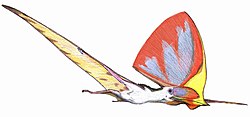Galgadraco
| Galgadraco Temporal range: Late Cretaceous,
| |
|---|---|

| |
| Holotype specimen and illustration of its placement (white) in a generalized azhdarchid skull | |
| Scientific classification | |
| Kingdom: | Animalia |
| Phylum: | Chordata |
| Class: | Reptilia |
| Order: | †Pterosauria |
| Suborder: | †Pterodactyloidea |
| Clade: | †Azhdarchoidea |
| Family: | †Azhdarchidae |
| Genus: | †Galgadraco Giaretta et al., 2025 |
| Species: | †G. zephyrius
|
| Binomial name | |
| †Galgadraco zephyrius Giaretta et al., 2025
| |
Galgadraco is an extinct genus of azhdarchid pterosaurs known from the Late Cretaceous (Maastrichtian age) Serra da Galga Formation of Brazil. The genus contains a single species, Galgadraco zephyrius, known from a fragment of the upper beak. It represents the first pterosaur described from the Bauru Group.[1]
Discovery and naming
[edit]The Galgadraco holotype specimen, CPPLIP 1853, was discovered in outcrops of the Serra da Galga Formation, about 25 kilometres (16 mi) north of Uberaba, Brazil. The specimen comprises an isolated fragment of the rostrum, deriving from near the tip of the upper jaw.[1]
In 2025, Giaretta and colleagues described Galgadraco zephyrius as a new genus and species of azhdarchid pterosaur based on these fossil remains. The generic name, Galgadraco, combines a reference to both the Serra da Galga Formation and Galga Hill, with the Latin word draco, meaning "dragon". The specific name, zephyrius, is derived from Zéphuros (Ζέφυρος), the Ancient Greek embodiment of the west wind.[1]
Description
[edit]
Based on the proposed close relationships with Albadraco and similarities of the proportions and size of the overlapping rostral elements, Giaretta and colleagues determined that the holotypes of these two pterosaurs would have come from individuals of comparable body sizes. The fourth cervical (neck) vertebra of Albadraco has a maximum width of 7 centimetres (2.8 in) at the prezygapophyses, similar to the corresponding element in Quetzalcoatlus lawsoni. From this, they concluded that a wingspan of around 4–5 m (13–16 ft) was fitting, making Galgadraco a medium-to-large-sized pterosaur,[1] not a giant one like Quetzalcoatlus northropi or a small taxon like Tsogtopteryx.[2][3]
Classification
[edit]To determine the relationships and affinities of Galgadraco, Giaretta and colleagues scored it in a comprehensive pterosaur-focused phylogenetic matrix modified from Zhou et al. (2025),[4] deriving from Pêgas (2024).[5] Their analyses recovered Galgadraco as the sister taxon to the Romanian Albadraco,[6] in a clade also containing Hatzegopteryx, Cryodrakon, and Tsogtopteryx. The results are displayed in the cladogram below,[1] with clade names following Pêgas et al. (2025):[3]
| Azhdarchidae |
| |||||||||||||||||||||||||||||||||||||||||||||||||||||||||
References
[edit]- ^ a b c d e Giaretta, Ariovaldo A.; Navarro, Bruno A.; Marinho, Thiago S.; Pêgas, R. Vargas (September 2025). "The first pterosaur from the Bauru Group: an azhdarchid from the Upper Cretaceous of Brazil". Papers in Palaeontology. 11 (5). doi:10.1002/spp2.70039. ISSN 2056-2799.
- ^ Andres, B.; Langston, W. Jr. (2021). "Morphology and taxonomy of Quetzalcoatlus Lawson 1975 (Pterodactyloidea: Azhdarchoidea)". Journal of Vertebrate Paleontology. 41 (sup1): 46–202. Bibcode:2021JVPal..41S..46A. doi:10.1080/02724634.2021.1907587. ISSN 0272-4634. S2CID 245125409.
- ^ a b Pêgas, R. V.; Zhou, Xuanyu; Kobayashi, Yoshitsugu (2025). "Azhdarchid pterosaur diversity in the Bayanshiree Formation, Upper Cretaceous of the Gobi Desert, Mongolia". PeerJ. 13 e19711. doi:10.7717/peerj.19711. PMC 12447946.
- ^ Zhou, Xuanyu; Ikegami, Naoki; Pêgas, Rodrigo V.; Yoshinaga, Toru; Sato, Takahiro; Mukunoki, Toshifumi; Otani, Jun; Kobayashi, Yoshitsugu (March 2025). "Reassessment of an azhdarchid pterosaur specimen from the Mifune Group, Upper Cretaceous of Japan". Cretaceous Research. 167 106046. Bibcode:2025CrRes.16706046Z. doi:10.1016/j.cretres.2024.106046. ISSN 0195-6671.
- ^ Pêgas, Rodrigo V. (2024-06-10). "A taxonomic note on the tapejarid pterosaurs from the Pterosaur Graveyard site (Caiuá Group, ?Early Cretaceous of Southern Brazil): evidence for the presence of two species". Historical Biology: 1–22. doi:10.1080/08912963.2024.2355664. ISSN 0891-2963.
- ^ Solomon, A.; Codrea, V.; Venczel, M.; Grellet-Tinner, G. (June 2020). "A new species of large-sized pterosaur from the Maastrichtian of Transylvania (Romania)". Cretaceous Research. 110 104316. Bibcode:2020CrRes.11004316S. doi:10.1016/j.cretres.2019.104316.
- ^ Vremir, Mátyás; Witton, Mark; Naish, Darren; Dyke, Gareth; Brusatte, Stephen L.; Norell, Mark; Totoianu, Radu (March 17, 2015). "A Medium-Sized Robust-Necked Azhdarchid Pterosaur (Pterodactyloidea: Azhdarchidae) from the Maastrichtian of Pui (Haţeg Basin, Transylvania, Romania)". American Museum Novitates (3827): 1–16. doi:10.1206/3827.1. ISSN 0003-0082.
- ^ Longrich, Nicholas R.; Martill, David M.; Andres, Brian; Penny, David (2018). "Late Maastrichtian pterosaurs from North Africa and mass extinction of Pterosauria at the Cretaceous-Paleogene boundary". PLOS Biology. 16 (3) e2001663. doi:10.1371/journal.pbio.2001663. PMC 5849296. PMID 29534059.













